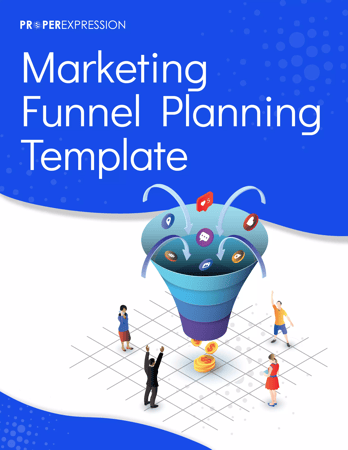73% of B2B marketers use content marketing as a part of their overall strategy, and 54% of marketers plan on increasing their content budget in the coming years.
But many marketers still shy away from a fully-fledged content marketing strategy because they don’t see its value in driving revenue, or they don’t have the resources to produce ongoing content. In these cases, they elect to publish occasional content without deliberate thought.
Unfortunately for them, simply publishing one blog every other week is not enough to gain real traction and return on investment (ROI) when it comes to content.
Understanding the role that content plays in B2B marketing and B2B SaaS marketing at every stage of the funnel is how marketers can begin to drive real, consistent conversions using blogs, white papers, and more.
That’s why the best marketers develop a content marketing strategy that goes beyond treating content as just another box to check. Such a strategy is designed to achieve business goals by understanding the needs of prospects at every point in their journey and creating material that will resonate with them and their pain points and ultimately guide them through the funnel.
Read on to discover how to identify the needs in your marketing and sales funnels, build a strategy around those needs, and execute effective content that paves a smooth conversion path for every prospect.
What is a B2B Content Marketing Strategy?
A B2B content marketing strategy is a comprehensive plan that outlines how a business intends to create, distribute, and promote valuable and relevant content to attract, engage, and convert a target audience.
With a digital content marketing strategy, B2B companies use content like blog posts, white papers, videos, and more as a strategic tool to communicate with prospects at every stage of the marketing and sales journey. The strategy aims to drive brand awareness, establish thought leadership, nurture relationships, and meet key performance indicators (KPIs).
How to Create a Content Marketing Strategy
A well-defined content marketing strategy should include the following components:
- Set Goals: Clearly define the objectives you want to accomplish through content marketing. This could include increasing brand visibility, driving website traffic, generating leads, enhancing customer loyalty, or improving conversions.
- Identify Your Target Audience: Identify your target audience or buyer personas. Understand their demographics, firmographics, pain points, and behaviors to create content that resonates with them at every stage of the marketing and sales funnels.
- Research Topics: Conduct thorough research to identify relevant topics and keywords that align with your audience's interests and needs. Explore trending industry topics and influencers, and conduct competitor analysis and keyword research to guide your content ideation and creation processes.
- Choose Marketing Channels: Identify the channels where members of your target audience spend their time consuming content. This could be social media or industry publications, among other channels. With this research, you can align format content to the unique needs of each distribution channel.
- Produce Content: Develop a content creation plan that includes various formats such as blog posts, white papers, videos, infographics, case studies and social media posts. Focus on delivering valuable and engaging content that educates, entertains, inspires, or solves problems for your target audience.
- Distribute Materials: Once you’ve identified channels of distribution and tailored your content to each platform, it’s time to start publishing your new assets. Note that content consumption often differs at each stage of the funnel, which is important to factor in when creating your content distribution strategy to reach your audience effectively.
- Emphasize SEO: Optimize your content for search engines by incorporating relevant keywords, meta tags, and descriptions. This improves your content's visibility in search engine results and increases organic traffic to your website.
- Promote and Amplify: Develop a plan to promote your content through paid advertising, social media promotion, influencer partnerships, backlinking campaigns, email marketing, website pop-ups, and other channels. Amplify your content to reach a wider audience and increase engagement.
- Track and Analyze: Implement tools to track the performance of your content marketing efforts. Monitor key metrics such as website traffic, engagement rates, conversion rates, and social media metrics. Analyze the data to gain insights, make data-driven decisions, and refine your strategy and assets as needed.
- Iterate Content: Continuously review and update your content marketing strategy based on the insights and feedback gathered. Adapt to changing market trends, audience preferences, and evolving business goals to maximize the effectiveness of your content.
A successful content marketing strategy requires consistency, quality, and relevance. By delivering valuable content to your audience, you can build trust, establish your brand as an authority, and drive meaningful results.
Best Ideas and Examples of B2B Content Marketing Strategies
The best B2B marketers use content at every stage of the funnel to create a cohesive and harmonious journey for prospects. The content at the top, middle, and bottom of the funnel should align with the needs, interests, and questions of the target audience at that particular point in their buying journey.

- Blog posts: Create informative and educational blog posts that address common pain points, challenges, or questions your target audience may have. Incorporate relevant keywords to drive organic traffic.
- Pillar pages: Establish credibility and educate the audience with a central hub of information that answers all potential questions on a specific topic and links to other pieces of relevant content. This generates more leads and showcases definitive thought leadership. (Check out The Complete Guide to Hiring & Working with a Growth Marketing Agency for an example of a pillar page.)
- eBooks: Offer downloadable resources that provide in-depth information on a specific topic related to your industry or expertise. This helps establish your brand as an industry authority.
- Checklists: Provide digestible, actionable information on specific topics or tasks that prospects can easily download and follow to increase topic awareness, encourage engagement and sharing, and deliver real value to prospects in the awareness stage.
- Case studies: Present real-life examples of how your product or service has benefited existing customers. Showcase the value and success your brand brings to potential customers.
- White papers: Publish in-depth reports or studies that provide valuable insights and data relevant to your industry or target audience's interests.
- Webinars: Conduct live or recorded webinars that delve deeper into specific topics, demonstrate your expertise, and allow for interactive engagement with potential customers.
- Comparison guides: Create content that compares your products or services with alternatives in the market, highlighting your unique value proposition and helping prospects make informed decisions.
- Testimonials/customer reviews: Share testimonials or reviews from satisfied customers to build trust and credibility and address potential customers' concerns or objections.
- More in-depth case studies: Present detailed case studies highlighting how your product or service has successfully solved a particular problem or achieved specific customer results. In contrast to a MOFU case study, this should be longer and include more data.

- Product demo/free trial-related content: Send content that offers free trials, demos, or limited access to your product or service to allow potential customers to experience its value firsthand. Offers should showcase the features and benefits of the product.
Benefits of Implementing a Smart B2B Content Marketing Strategy
When done right, B2B content marketing offers a powerful set of benefits that extend far beyond just increased brand visibility. A smart strategy is built with purpose and performance in mind, helping companies deliver value at scale and turn prospects into loyal customers.
Here are some of the top benefits of implementing a strong B2B content marketing strategy:
Builds Trust and Credibility: Consistently providing helpful, relevant, and insightful content allows your brand to position itself as a thought leader. This builds trust with your audience and increases the likelihood of them choosing your business over competitors.
Supports the Entire Buyer Journey: From awareness to conversion, content marketing enables businesses to engage prospects with the right message at the right time. This level of personalization drives deeper engagement and helps guide users down the funnel more efficiently.
Increases Organic Visibility and Traffic: Strategic SEO-driven content improves your visibility in search engines, attracting quality leads who are actively searching for what you offer. High-ranking blog posts, pillar pages, and guides can bring in consistent, compounding traffic over time.
Generates High-Quality Lead: Lead magnets like white papers, eBooks, and webinars help capture contact information and initiate meaningful relationships. With the right nurture strategy, this can significantly improve lead quality and pipeline health.
Reduces Customer Acquisition Costs: Compared to traditional outbound methods, inbound content marketing is often more cost-effective and scalable. The content you produce today continues to deliver value long into the future.
Enhances Customer Retention: Content isn’t just for new leads—it’s also key for maintaining customer relationships. Case studies, support articles, and helpful product content help drive ongoing satisfaction and loyalty.

B2B Content Marketing Trends: AI and Tips for the Near Future
The content marketing landscape is evolving quickly, and AI is playing a major role in shaping its future. As tools become more sophisticated, B2B marketers have new opportunities to increase efficiency, creativity, and personalization in their strategies.
Here are the top AI trends and tips you should watch for:
AI-Powered Content Creation: Generative AI is being used to assist with drafting blog posts, generating headlines, summarizing research, and more. While AI can support speed and ideation, human oversight is still critical to maintain quality, tone, and originality.
Predictive Content Optimization: AI tools are increasingly being used to analyze content performance and recommend optimizations based on user behavior. From SEO adjustments to CTA placements, AI enables smarter, faster improvements that boost ROI.
Hyper-Personalization at Scale: AI allows marketers to serve more relevant content to users based on their industry, role, and behavior. This makes your email campaigns, landing pages, and retargeting efforts significantly more effective.
Conversational AI and Chatbots: B2B websites are beginning to use AI-powered chatbots that can suggest content based on user queries. These tools can also guide users through complex decision-making paths, improving engagement and reducing friction.
Ethical Use and Transparency: As AI becomes more embedded in marketing, companies need to stay transparent about how it’s used—especially in content creation. It’s important to prioritize trust, accuracy, and brand voice.
Pro Tip: Use AI to support your strategy, not replace it. The best results come from blending AI’s speed with human creativity and strategic oversight.
23 B2B Content Marketing Tactics (from Top Digital Agency Experts)
Want to level up your B2B content marketing strategy? Here are 23 powerful tactics recommended by top agency experts to improve performance and reach in 2025:
- Create SEO-optimized blog content regularly
- Develop comprehensive pillar pages
- Use topic clusters to build authority
- Offer gated lead magnets like eBooks
- Produce original research or surveys
- Host educational webinars
- Create downloadable checklists or templates
- Repurpose long-form content into bite-sized assets
- Launch interactive tools or calculators
- Leverage video for product explainers and testimonials
- Use infographics to simplify complex data
- Write detailed case studies focused on outcomes
- Create comparison guides to highlight your USP
- Build out an FAQ hub for SEO and support
- Optimize old content for improved performance
- Feature guest content from industry influencers
- Use user-generated content in your campaigns
- Build email nurture sequences for every persona
- Test different content formats on social
- Create buyer’s guides tailored to each funnel stage
- Launch an educational podcast series
- Incorporate storytelling in your copywriting
- Collaborate with your sales team to develop sales enablement content
Not every tactic will be right for your brand—but selecting a combination based on your audience’s behavior and funnel stage can help you scale sustainably and effectively.
Why Having a Good Content Marketing Strategy is Important for B2B
A strong content marketing strategy is essential for B2B brands looking to stand out, build trust, and drive revenue. It ensures every piece of content—whether a blog post, case study, or white paper—serves a clear purpose across the buyer journey. With a thoughtful, well-executed plan, marketing and sales teams can align around shared goals, engage the right audience with relevant material, and convert interest into action. It also provides a foundation for scalable, measurable growth and long-term brand authority.
At ProperExpression, we help B2B companies create content strategies that do more than generate clicks—they generate results. Explore our content marketing solutions to see how we can help drive real impact for your business.







